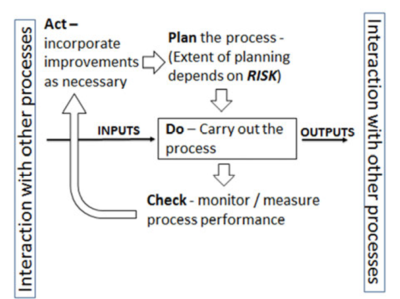Deming wheel
| Deming wheel |
|---|
| See also |
Deming wheel is also known as PDCA cycle. It is a basic tool that helps to continuously improve the processes in the organization. It is also used to solve the quality problems as well as implement new solutions and ideas. The PDCA cycle consists of four steps which one shall go through to get from finding and realizing the problem to solving the problem. PDCA refers to an acronym built around the four stages of this tool. The four stages are Plan-Do-Check-Act, which is presented on the illustration.
The PDCA Cycle is used in order to coordinate the continuous improvement in the enterprise. It emphasizes that improvement programs must start with careful planning, result in effective action, and must move on again to careful planning in a continuous cycle.
Stages of PDCA cycle
Stage 1. Plan
Plan to improve the process first by finding out what things are going wrong and come up with ideas for solving these problems. Following methods should help in this stage:
- Fish diagram - find causes of your current situation
- 7 quality tools - collect data to better understand the process
- 5 Whys - simpler version of Ishikawa chart
- Failure Mode and Effects Analysis - identify possible problems
Stage 2. Do
Design changes and implement in the small scale. In this stage you should create solutions to your problem, choose the best one and plan the implementation. Do not implement changes across the board. Begin with experiments. The methods that may be helpful are:
- Experiment planning methods by Genichi Taguchi
- 5S method
- Total Productive Maintenance
- Quality loss function
Stage 3. Check
Measure whether the small scale or experimental changes achieved the desired result. Continuously check the key activities to ensure that the quality of the output at all times is known and controlled. Identify any new problems which may appear during the process run.
The most helpful methods at this stage will be 7 quality tools.
Stage 4. Act
Act to implement changes on a larger scale if the experiment is successful. This means making the changes a routine part of your activity. Also Act to involve other persons (other departments, suppliers, or customers) affected by the changes and whose cooperation is needed to implement them on a larger scale, or those who may simply benefit from the change. This action may be also practised in the first stage of Planning.
Repeat with another problem
When the cycle is completed and the problem is solved it is required to go back to the Plan stage to identify the next problem. If the experiment is not successful, the Act step should be omitted and the new cycle must be started. In the "Plan" step new ideas for solving the problem should be found. And the new cycle begins.
The improvement never ends.
The PDCA tool promotes the teamwork, therefore it should be used in team meetings to take stock of what stage improvement initiatives are at, and to choose the appropriate tools to see each stage through to successful completion.
History of PDCA cycle
The concept of the PDCA cycle was originally developed by Walter A. Shewhart, the pioneering statistician who developed statistical process control in the US during the 1930s. It was developed and promoted since the 50s by William Edwards Deming, and nowadays is known as the Deming Wheel.
PDCA cycle was popularized as a tool of Total Quality Management. It was also included into process approach described in ISO 9001 standard in 2000 issue. The draft of ISO 9001:2015 contained a drawing which presented process approach through PDCA cycle, however it was removed from the final version.
The cycle is known under several names, including: Deming wheel, Deming cycle, PDCA, Shewhart cycle, PDSA. The original Shewhart cycle (1939) had however only three steps:
- specification,
- production,
- inspection,
and was extended by W. Edwards Deming only in 1950 in format different from what is known today:
This version was presented for JUSE in Japan. It is not known who translated this into PDCA version.
The PDSA comes from Plan - Do - Study - Act. It was published by W. Edwards Deming in 1986 and called... Shewhart cycle. The study emphasises the need of creating new knowledge.
Models based on PDCA
The PDCA cycle was implemented in many models. The most interesting is evolution of PDCA used in Six sigma - DMAIC cycle. DMAIC is modified PDCA cycle, which includes:
- Define the goals
- Measure characteristics that are critical to quality
- Analyse the process and product and develop alternatives
- Improve the product and process
- Control the future state of the process (to avoid entropy)
The other example is ISO 9001 standard, which uses PDCA cycle to describe system approach used in the standard.
Benefits of using PDCA cycle
- Applicability to all types of organization, groups, levels, and any repeatable activities
- Provision of framework for application of further improvement methods and tools
- Enabling adaptation of plans and projects as the learning occurs
- Provision of simple way for people to empower themselves
- Facilities the teamwork
References
- Imai, M. (1988), Kaizen (Ky'zen), the key to Japan's competitive success, McGraw-Hill.
- Latzko, W. J., Saunders, D. M. (1995), Four Days with Dr. Deming: A Strategy for Modern Methods of Management, Addison Wesley Lomgman Inc.
- Moen, R., & Norman, C. (2006). Evolution of PDCA cycle Evolution of the PDCA cycle.
- Moen, R. (2009). Foundation and History of the PDSA Cycle.
- Singh, V. K. (2013). PDCA Cycle: A quality approach. Utthan–The Journal of Management Sciences, 1(1).
- Sokovic, M., Pavletic, D., & Pipan, K. K. (2010). Quality improvement methodologies–PDCA cycle, RADAR matrix, DMAIC and DFSS. Journal of Achievements in Materials and Manufacturing Engineering, 43(1), 476-483.
- Walton, M. (1988). The Deming management method. Penguin.
- The W. Edwards Deming Institute website.
Author: Slawomir Wawak


